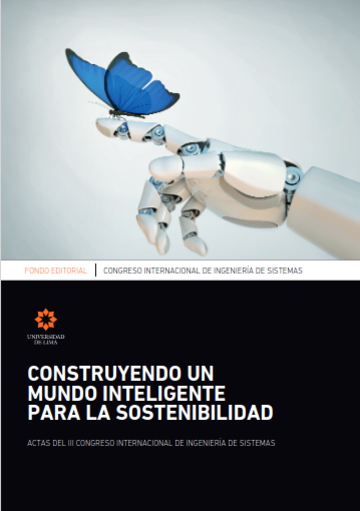La importancia de la pobreza en las políticas de sostenibilidad: un enfoque para comprender la online opinion
DOI:
https://doi.org/10.26439/ciis2020.5476Palabras clave:
análisis de redes sociales, pobreza, objetivos de desarrollo sostenible (ODS), desarrollo sostenibleResumen
Los datos de Twitter relacionados con la pobreza y los ingresos básicos se reco pilaron durante 24 días en el 2019, se limpiaron y se prepararon para el procesamiento del lenguaje natural (natural language processing). Un subconjunto del 7 % de los datos se etiquetó manualmente para el análisis de sentimientos con el fin de informar a la inteligencia artificial (IA). La IA fue entrenada y verificada en este subconjunto. Presentamos los resultados tanto de la muestra del 7 % como de toda la base de datos. Este análisis de la opinión pública sobre la pobreza se sitúa dentro de los objetivos de desarrollo sostenible y el apoyo a las políticas de reducción de la pobreza.
Descargas
Referencias
Andreotta, M., Nugroho, R., Hurlstone, M. J., Boschetti, F., Farrell, S., Walker, I., & Paris, C. (2019). Analyzing social media data: A mixed-methods framework combining computational and qualitative text analysis. Behavior Research Methods, 51(4), 1766-1781. https://doi.org/10.3758/s13428-019-01202-8
Arias, M., Arratia, A., & Xuriguera, R. (2014). Forecasting with twitter data. ACM Transactions on Intelligent Systems and Technolog y, 5(1), 8:1-8:24. https://doi.org/10.1145/2542182.2542190
Bird, S., Klein, E., & Loper, E. (2009). Natural Language Processing with Python: Analyzing Text with the Natural Language Toolkit. O’Reilly Media, Inc.
Brooks, D. (2019, April 4). Opinion|Winning the War on Poverty. The New York Times. https://www.nytimes.com/2019/04/04/opinion/canada-poverty-record.html
Chakraborty, K., Bhatia, S., Bhattacharyya, S., Platos, J., Bag, R., & Hassanien, A. E. (2020). Sentiment Analysis of COVID-19 Tweets by Deep Learning Classifiers—A study to Show how Popularity is Affecting Accuracy in Social Media. Applied Soft Computing, 97, 106754. https://doi.org/10.1016/j.asoc.2020.106754
Chen, N.-C., Drouhard, M., Kocielnik, R., Suh, J., & Aragon, C. R. (2018). Using Machine Learning to Support Qualitative Coding in Social Science: Shifting the Focus to Ambiguity. ACM Trans. Interact. Intell. Syst., 8(2), 9:1–9:20. https://doi.org/10.1145/3185515
Daityari, S. (2019, September 26). How To Perform Sentiment Analysis in Python 3 Using the Natural Language Toolkit (NLTK). DigitalOcean. https://www.digitalocean.com/community/tutorials/how-to-perform-sentiment-analysis-in-python-3-using-the-natural-language-toolkit-nltk
Earl, J. (2016). “Slacktivism” that works: “Small changes” matter. The Conversation. http://theconversation.com/slacktivism-that-works-small-changes-matter-69271
Farzindar, A., & Inkpen, D. (2015). Natural Language Processing for Social Media. Morgan & Claypool Publishers. http://gen.lib.rus.ec/book/index.php?md5=10fbd73c15d6d25d8776c08835e45040
Finn, S., & Mustafaraj, E. (2013). Learning to Discover Political Activism in the Twitterverse. KI - Künstliche Intelligenz, 27(1), 17–24. https://doi.org/10.1007/s13218-012-0227-y
Global Affairs Canada-Affaires mondiales Canada. (2017, June 8). The 2030 Agenda for Sustainable Development. GAC. https://www.international.gc.ca/world-monde/issues_development-enjeux_developpement/priorities-priorites/agenda-programme.aspx?lang=eng
Government of Canada, S. C. (2019, February 26). Low income statistics by age, sex and economic family type. https://www150.statcan.gc.ca/t1/tbl1/en/tv.action?pid=1110013501
Greaves, F., Ramirez-Cano, D., Millett, C., Darzi, A., & Donaldson, L. (2013). Use of Sentiment Analysis for Capturing Patient Experience From Free-Text Comments Posted Online. Journal of Medical Internet Research, 15(11), e239. https://doi.org/10.2196/jmir.2721
International Telecommunication Union. (2020). Individuals Using the Internet ( Percentage of population)—Canada |Data. The World Bank. https://data.worldbank.org/indicator/IT.NET.USER.ZS?locations=CA
Keramatfar, A., & Amirkhani, H. (2019). Bibliometrics of Sentiment Analysis Literature. Journal of Information Science, 45(1), 3-15. https://doi.org/10.1177/0165551518761013
Kumar, A., & Garg, G. (2020). Systematic Literature Review on Context-Based Sentiment Analysis in Social Multimedia. Multimedia Tools and Applications, 79(21-22), 15349-15380. https://doi.org/10.1007/s11042-019-7346-5
Kumar, A., & Jaiswal, A.(2020). Systematic Literature Review of Sentiment Analysis on Twitter Uusing Soft Computing Techniques. Concurrency and Computation: Practice and Experience, 32(1), e5107. https://doi.org/10.1002/cpe.5107
McGregor, K. A., & Whicker, M. E. (2018). Natural Language Processing Approaches to Understand HPV Vaccination Sentiment. Journal of Adolescent Health, 62(2), S27-S28. https://doi.org/10.1016/j.jadohealth.2017.11.055
Neuendorf, K. A., & Kumar, A. (2016). Content Analysis. In The International Encyclopedia of Political Communication (pp. 1-10). American Cancer Society. https://doi.org/10.1002/9781118541555.wbiepc065
Nexalogy. (2020). Nexalogy. https://nexalog y.com/
Oliveira, N., Cortez, P., & Areal, N. (2017). The Impact of Microblogging Data for Stock Market Pprediction: Using Twitter to Predict Returns, Volatility, Trading Volume and Survey Sentiment Indices. Expert Syst. Appl. https://doi.org/10.1016/j.eswa.2016.12.036
Patel, J., Dubey, R., & Gupta, R. K. (2020). PMI-IR Based Sentiment Analysis Over Social Media Platform for Analysing Client Review. In S. Smys, T. Senjyu, & P. Lafata (Eds.), Second International Conference on Computer Networks and Communication Technologies (pp. 204–212). Springer International Publishing. https://doi.org/10.1007/978-3-030-37051-0_23
Reyes-Menendez, A., Saura, J. R., & Alvarez-Alonso, C. (2018). Understanding #World EnvironmentDay User Opinions in Twitter: A Topic-Based Sentiment Analysis Approach. International Journal of Environmental Research and Public Health, 15(11), 2537. https://doi.org/10.3390/ijerph15112537
Sanz-Hernández, A. (2019a). Medios de comunicación y stakeholders: Contribución al debate público de la pobreza y justicia energética en España/Media and Stakeholders: Contribution to the Public Debate on Poverty and Energy Justice in Spain. Revista Española de Investigaciones Sociológicas, 168. https://doi.org/10.5477/cis/reis.168.73
Sanz-Hernández, A. (2019b). Social Engagement and Socio-Genesis of Energy Poverty as a Problem in Spain. Energy Policy, 124, 286-296. https://doi.org/10.1016/j.enpol.2018.10.001
Slater, M. (2018). By the numbers: Twitter Canada at Dx3 2018. Blog Twitter. https://blog.twitter.com/en_ca/topics/insights/2018/TwitterCanada_at_Dx3.html
Tuarob, S., Tucker, C. S., Salathe, M., & Ram, N. (2014). An Ensemble Heterogeneous Classification Methodology for Discovering Health-Related Knowledge in Social Media Messages. Journal of Biomedical Informatics, 49, 255–268. https://doi.org/10.1016/j.jbi.2014.03.005
United Nations. (2019). The Sustainable Development Goals Report 2019. https://www.unilibrary.org/content/publication/55eb9109-en
United Nations Statistics Division. (2019, December 20). SDG Indicators. Sustainable Development Goal Indicators Website. https://unstats.un.org/sdgs/indicators/database


